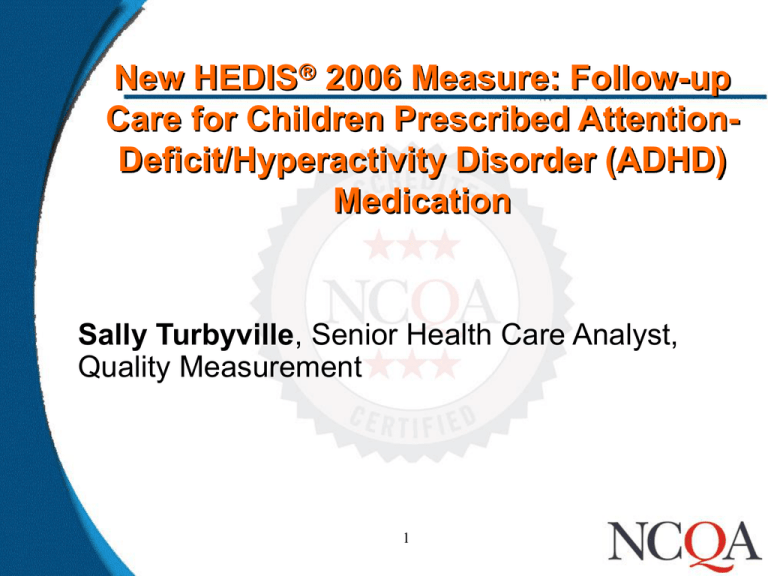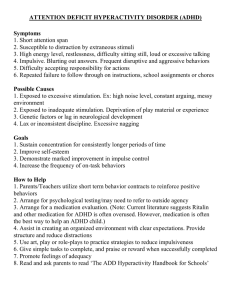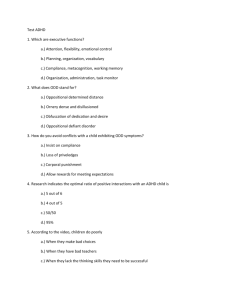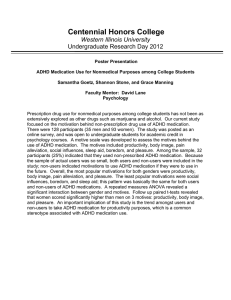New HEDIS 2006 Measure: Follow-up Care for Children Prescribed Attention- Deficit/Hyperactivity Disorder (ADHD)
advertisement

New HEDIS 2006 Measure: Follow-up Care for Children Prescribed AttentionDeficit/Hyperactivity Disorder (ADHD) Medication Sally Turbyville, Senior Health Care Analyst, Quality Measurement 1 Importance • Attention-deficit/hyperactivity disorder is one of the more common chronic conditions of childhood. • Children with ADHD may experience significant functional problems such as school difficulties, academic underachievement, troublesome relationships with family members and peers, and behavioral problems. • Pharmacologic treatment with psychostimulants is the most widely studied treatment for ADHD. • The long-term care management for a child with ADHD requires an ongoing partnership among clinicians, parents and the child. 2 Purpose • Develop a health plan level measure to assess timely follow-up care for children prescribed ADHD medications • Determine accuracy of administrative data to identify population and follow-up care 3 Data Source • Health plan administrative data – Member demographics and enrollment – Pharmacy claims – Ambulatory claims or encounters • Six health plans participated – 6 commercial – 3 Medicaid 4 Study Design • Cross-sectional health plan data – 5288 children identified – 867 medical record charts reviewed for validation 5 Timely Follow-Up • AAP Clinical Practice Guideline1 – “Once the child [ages 6 – 12 years] is stable, an office visit every 3 to 6 months allows for assessment of learning and behavior.” • AACAP Practice Parameter 2 – “Once the child with ADHD is stabilized on stimulant medication, visits may be scheduled once a month.” • Expert input 6 Method of Measurement Follow-up during start of treatment (Initiation Phase) • Denominator – Children between the ages of 6 and 12 years – Starting a new treatment of ADHD-specific medication. A new treatment requires no evidence of ADHD medication during the previous 120 days (4 months) of the dispensing date. • Numerator – One visit within 30 days after the dispensing event with practitioner who has prescribing authority. 7 Method of Measurement Follow-up during continued treatment (Continuation and Maintenance Phase) • Denominator – Children who remain on ADHD medication for 9 months after starting a new treatment. • Numerator – Two additional visits within 9 months after the “initiation” phase ends event with any practitioner. One of these two may be telephonic. 8 Health Plan Denominator • Prevalence of enrolled 6 – 12 year olds – commercial: 16.3 per 1,000 members – Medicaid: 22.6 per 1,000 members 9 Defining the Denominator • Requiring a diagnosis of ADHD significantly reduces denominator size: – Denominator size dropped by 42%. • ADHD diagnosis confirmed in medical record or administrative data – 96.8% of the children identified had a diagnosis of ADHD 10 Defining the Numerator Follow-Up Rates-Requiring ADHD Diagnosis Commercial Medicaid 50 Rate 40 45 43 42 40 30 23 20 17 19 14 10 0 Initiation Initiation Dx C&M 11 C&M Dx Timely Follow-Up % Mean Initiation Commercial 42.8 % Range 31.3 – 49.5 Medicaid 45.0 33.3 – 46.7 Continuation & Maintenance Commercial 40.0 24.8 – 48.3 Medicaid 42.1 31.4 – 43.7 12 Conclusions • Pharmacy claims data reliably identifies children with ADHD who are taking ADHD medication • Children are not receiving timely follow-up care after a starting new treatment of ADHD medication • Concern for quality of care • Health plan administrative data can be used to measure and encourage timely follow-up care for these children 13 Contributors • • • • • Charles Homer, MD • Terry Kramer, PhD • Mary Beth Kiser Marc Atkins, PhD Christy Beaudin, PhD Ann Doucette, PhD Richard Hermann, PhD • Partially funded by Eli Lilly and McNeil 14 Reference American Academy of Pedicatrics, Committee on Quality Improvement and Subcommittee on Attention-Deficit/Hyperactivity Disorder. Clinical Practice Guideline: Treatment of the School-Aged Child with AttentionDeficit/Hyperactivity Disorder. Pedicatrics. 2001; 108: 1033-1044. AACAP Official Action. Practice Parameter for the Use of Stimulant Medications in the Treatment of Children, Adolescents, and Adults. J.AM. ACAD. Child Adolesc. Psychiatry, 41:2 Supplement, February 2002. 15







